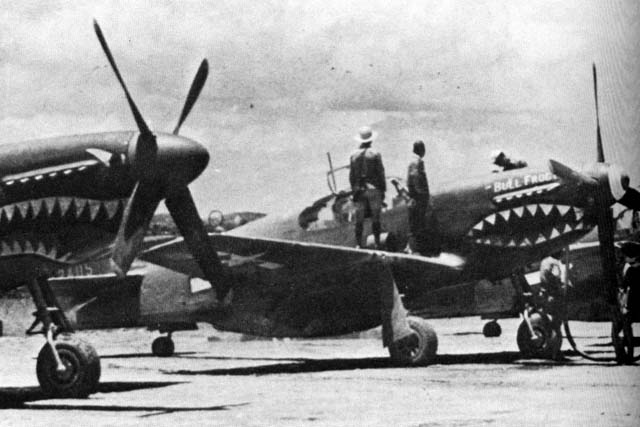Tex Hill – 23rd Fighter Squadron (part 5)
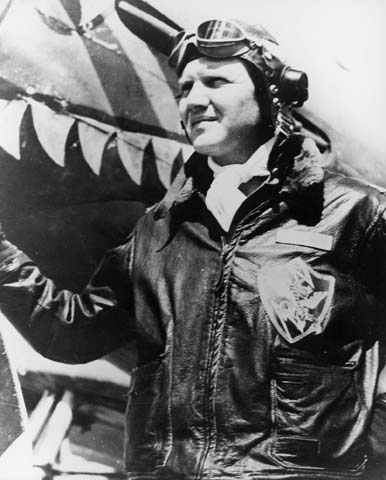 After the entry of the US into war, plans were made to disband the AVG and incorporate them into the Army Air Force. Since the AVG were technically civilians, the USAAF attempted to use strong arm tatics to force the men to join the USAAF voluntarily. This went off badly and resulted in most of the men leaving to return to the United States or joining up with the CNAC to fly supplies in C-47s from India to China. A handful choose to remain in China, only five pilots choose to stay and Tex Hill was among them he was personally asked to do so by Chennault.
After the entry of the US into war, plans were made to disband the AVG and incorporate them into the Army Air Force. Since the AVG were technically civilians, the USAAF attempted to use strong arm tatics to force the men to join the USAAF voluntarily. This went off badly and resulted in most of the men leaving to return to the United States or joining up with the CNAC to fly supplies in C-47s from India to China. A handful choose to remain in China, only five pilots choose to stay and Tex Hill was among them he was personally asked to do so by Chennault.
The AVG was deactivated in July, 1942. In its place was the new 23rd Fighter Group commanded by Robert Scott – who later wrote the best seller “God is My Copilot”. Hill was promoted to major and given command of the 75th Fighter Squadron. Along with his fellow veteran AVG pilots, he helped train the new USAAF pilots on how to fight the Japanese. This is how Don Lopez, a young pilot assigned to the 23rd FG, described a typical briefing Tex Hill style:
“You’ve seen in the film, Twelve O’Clock High, when the Eighth Air Force was going to have a big thousand-plane raid, all of the maps and pointers and different people giving briefings. Well, our briefing consisted of Tex Hill getting up and saying, “Y’all follow me.”
That was the whole briefing, and we did: and it worked very well.” By December 1942, he was promoted to Lieutenant Colonel and returned to the US to command the Proving Ground Group at Elgin Field, Florida. However, it was long before Chennault requested Hill to come back to China. It was an offer that Hill was eager to accept. In October of 1943, he returned to China, now as commander of the 23rd Fighter Group. In the same month, old P-51A Mustangs started to arrive from India to replace the old AVG P-40s.
On November of that year, the Mustangs were put to use in a raid on the Japanese Shinchiku airfield located at Formosa (present day Taiwan). The airfield had already been under aerial observation by the previous commander of the 23rd FG – Bruce Holloway. He related his plans to Hill, who was anxious to execute it. On the 24th, a F-5 reconnaissance flight over Shinchiku showed a large concentration of Japanese aircraft – they estimated at the time there was over 200 aircraft in total. The 23rd FG had already amassed eight P-51As, Fourteen B-25s from the Chinese American Composite Wing, and eight P-38s for just the right opportunity, and this was it.
As mission leader, Hill led the P-51’s from Kweilin to a forward base at Suichuan that morning, by the afternoon, P-38s and B-25s arrived. The mission was on for Thanksgiving day, and at a briefing that morning, the plan was laid out to the pilots. The planes would fly over 400 miles to Formosa, drop down to tree level to avoid detection and then climb to 1000 feet right before reaching the Japanese airfield. The P-38s would fly cover while the Mustangs will stay with the B-25s. Once the B-25s dropped their bombs, the fighters will take turns strafing the airfield.
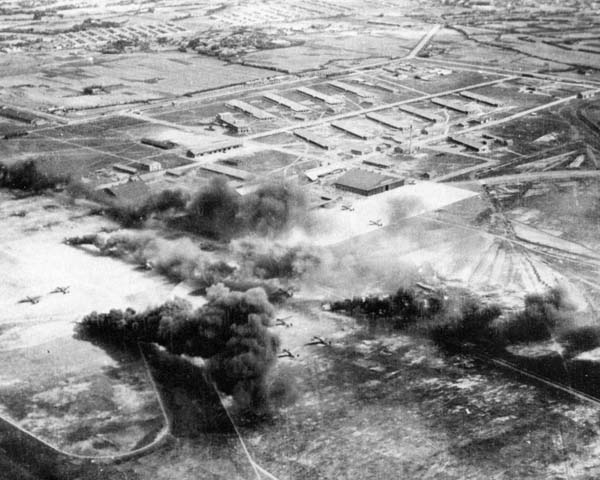
As they approached the airfield, Japanese bombers were just coming in for a landing. The B-25s immediately started their bombing run while the P-38s zone in on the Japanese bombers. Some Ki-43s were able to take off to challenge the Americans, but most were shot down, including one credited to Hill. He then proceeded to strafe Japanese bombers on the ground and as ammunition ran low, he shot at some troops in a nearby river. As Hill turned for home, a loud bang startled him, thinking he just got hit from an enemy plane he immediately jerked his plane into a dive. As he recovered, there was no enemy in sight and Hill realized it was his overheated guns that ‘cooked off’ an unspent shell. Based on a reconnaissance flight after the mission, he was credited with another Japanese aircraft destroyed on the ground and a probable. Tex became the first American to shoot down a Japanese plane in a Mustang.
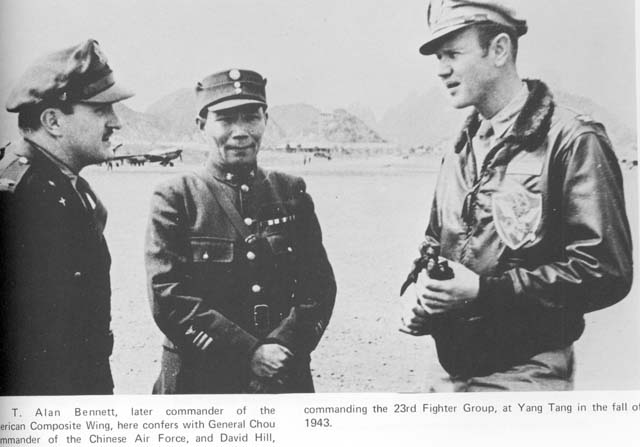
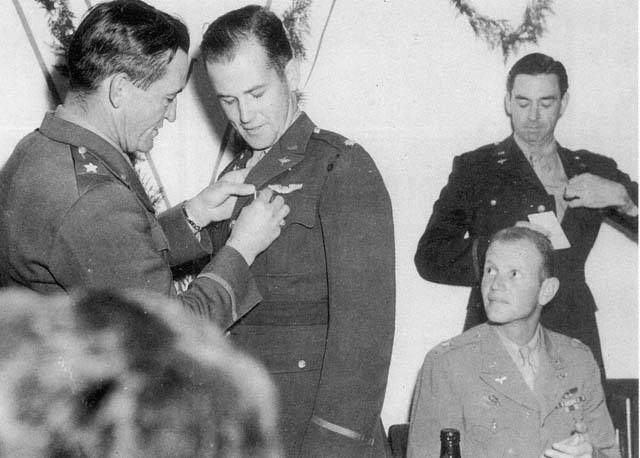
Tex Hill’s P-51B Mustang “BullFrog” (Serial #267)
 Article on building a model of this plane P-51 – 5th in the “Tex” Hill Series – ICM
Article on building a model of this plane P-51 – 5th in the “Tex” Hill Series – ICM
Tex was already familiar with the Mustang when he was in the US, having flown both the A and B model in Florida. The 76th Fighter Squadron was one of the first to receive P-51As. These old mustangs were excess inventory from the 311th Fighter Bomber Group assigned to India. The 311th kept the best planes and sent the rejects off to China. By March of 1944, the Merlin engine P-51B’s arrived and were distributed to the 23rd Fighter Group
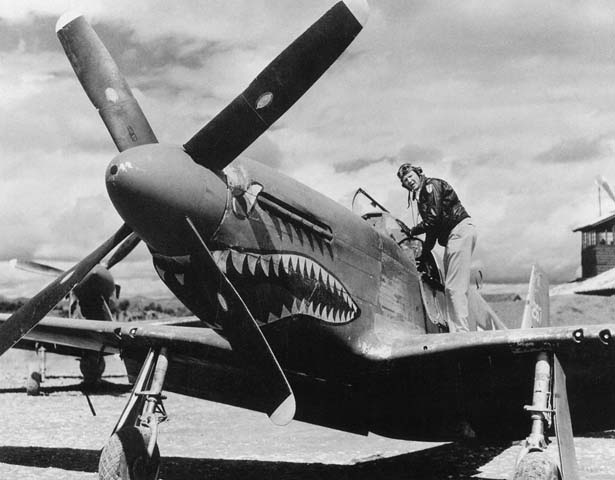
These Mustangs were left in their original Olive Drab scheme, with identifying yellow serial numbers on the rudder. There has been some confusion regarding Hill’s mustang “BullFrog”, as one his most famous photograph of this period is on top of a P-51B with 267 painted white on the rudder. The serial #43-6769 is often also associated with this plane, even though I don’t have any photographic evidence of this. The nose cone is often depicted a red and a double yellow band was painted on the rudder. Based on my research, the serial number does not match up with any assigned to the 23rd Fighter Group, and the double yellow band was only painted in 1944 for the 51st Fighter Group.
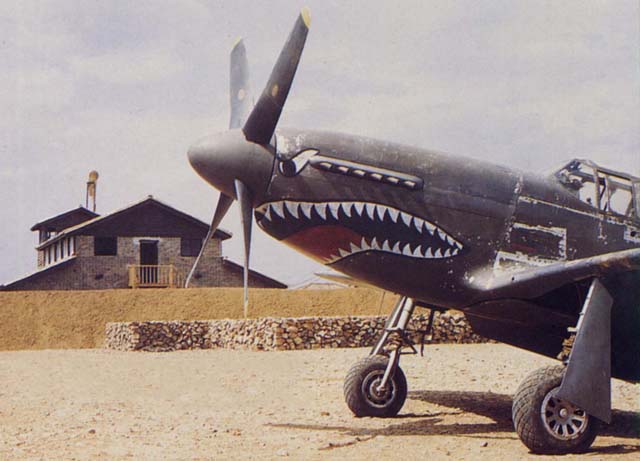
Tex actually was assigned to at least two different P-51Bs. The first was the just mentioned no 267 with an Olive drab nose cone. At some later point, this plane or different P-51B was assigned to Hill with a blue nose cone for the 76th Fighter Squadron’s color. This was the Mustang he took on the Formosa raid. His final P-51B had the nose painted red, white, and blue for the colors of the 3 different squadrons that Tex was now in charge of as the Commander of the Fighter Group. The rudder has white Roman numeral 11 and underneath in yellow, the serial 312405. “Bullfrog” was painted on the sides of the nose above the exhaust, “Bullfrog” was a nickname he had give to his wife, Maize. Some sources indicate the name was painted only on the port side – as seen in a picture included in Carl Molesworth’s book 23rd Fighter Group. However, I’ve included another picture in this article of the same plane showing “Bullfrog” on the starboard side also from Tex Hill.
